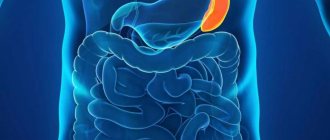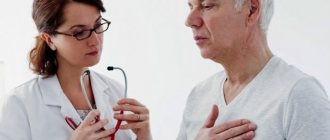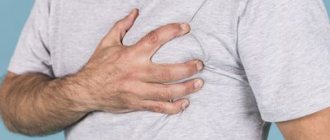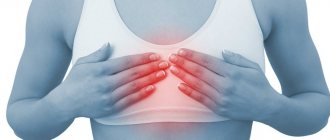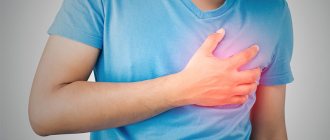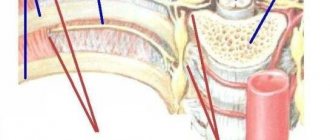Intercostal neuralgia is a pain syndrome: the sensation of pain occurs along one of the intercostal nerves. Acute, “shooting” pain in itself is a rather unpleasant factor, but in the case of intercostal neuralgia it is especially frightening. We usually interpret acute pain in the chest area as cardiac pain. If the nerve running between the lower ribs or the subcostal nerve (running under the lower rib) is affected, we may mistakenly believe that the source of pain is in the abdominal cavity.
How to distinguish intercostal neuralgia from heart pain
First of all, it is worth saying two things. First, you need to know that not all pain in the chest area is related to the heart. Therefore, you don’t need to be too scared right away. And second: the diagnosis can only be made by a doctor. If you have a tingling sensation in your chest, this is a significant reason to see a doctor. The doctor will figure out the cause of the pain. In addition, neuralgia also needs to be treated.
Intercostal neuralgia most often occurs in older people, but it also occurs at a young age (people who lead a sedentary lifestyle and also swimmers are at risk). In children, intercostal neuralgia can occur, as a rule, during a period of intensive growth.
A characteristic sign of intercostal neuralgia is severe pain along the affected nerve. The pain can come in attacks or be constant. As a rule, the pain becomes more intense when inhaling, exhaling, as well as any movement affecting the chest. If you press on the area between the ribs where the causative nerve passes, the pain intensifies. In this case, the entire nerve is felt; the pain can radiate to the arm, neck, shoulder, lower back. Along the affected nerve, numbness and blanching of the skin may occur.
Thus, if with pain in the chest area there is a dependence on changes in body position, there is no shortness of breath (a typical symptom of cardiac pathology), the pain intensifies with palpation, then most likely neuralgia is occurring. You can also focus on the effectiveness of the medications taken: cardiac medications do not help with neuralgia, but sedatives can reduce pain.
However, in any case, it is necessary to consult a doctor for a diagnosis and prescription.
Organs of the left hypochondrium
The left hypochondrium is the area located under the two lower ribs on the left side of the conditional middle of the abdomen. The following organs are located here:
- spleen;
- pancreas;
- left side of the stomach;
- aperture (left side);
- small intestine;
- colon;
- the left kidney and its ureter, as well as ligaments.
In addition, there are some other types of pain in this area that are not directly related to the above organs. They are a consequence of diseases of the internal organs in other areas of the abdomen or parts of the body and spread along nerve fibers (see below).
Causes of intercostal neuralgia
All causes of intercostal neuralgia can be reduced either to a pinched nerve root (the nerve is compressed at the point of exit from the spinal canal) or to irritation or compression of a nerve already in the intercostal space.
Intercostal nerve radicular syndrome is usually caused by one of the following:
- osteochondrosis of the thoracic spine;
- intervertebral hernia;
- tumor processes;
- other diseases of the spine.
Much more often, intercostal neuralgia occurs as a result of factors affecting the nerve in the intercostal space. The main reasons here are:
- chest injuries;
- herpes infection (herpes zoster);
- muscular-tonic syndrome due to excessive physical activity or working in an awkward position;
- hypothermia;
- for women - wearing tight underwear (bra). First of all, those who have a poorly developed subcutaneous fat layer should be careful;
- compression of the nerve by a growing tumor (pleura, chest wall) or an aneurysm of the descending thoracic aorta;
- factors affecting the entire nervous system (poisoning, hypovitaminosis).
Factors that increase the risk of intercostal neuralgia are:
- diabetes;
- problems with immunity;
- age-related changes in blood vessels;
- alcoholism;
- hormonal disorders;
- stress, depressed mental state;
- long-term use of potent medications.
Pain not associated with diseases
Sometimes completely healthy people or children experience pain in the left hypochondrium during active physical activity (sports, intense work). This usually happens when a person has a low level of training for these activities. The mechanism of this phenomenon is such that under the influence of load the level of blood circulation in the body increases sharply.
In response to this, all blood vessels increase in diameter, including the right vena cava, which runs next to the liver and begins to put pressure on it. As a result, a stabbing pain appears on the right side, which is transmitted to the left hypochondrium. A short time after the cessation of exposure, the pain reaction goes away on its own and does not require any therapeutic measures. Many schoolchildren encounter such manifestations during cross-country competitions or passing sports standards.
Sometimes similar pain sensations can appear with sudden movements or bending of the body. This is due to the contact of internal organs with the surface of the rib and, accordingly, the body’s protective reaction in the form of pain.
Methods for diagnosing intercostal neuralgia
If you suspect intercostal neuralgia, you should consult a neurologist.
In most cases, the diagnosis is established based on the patient’s complaints, medical history and examination of the patient directly at the appointment. The doctor pays attention to the patient’s posture: in an effort to reduce pain by reducing pressure on the affected nerve, the patient tilts the body in the opposite direction. The intercostal spaces are palpated in the area where the pain is located. Loss of sensitivity and blanching of the skin is established.
Sometimes instrumental and laboratory diagnostics may be required:
ECG
An ECG is performed in case of pain on the left side. The goal is to rule out heart problems. In combination with an ECG, echocardiography (ultrasound of the heart) may be prescribed. More information about the diagnostic method
Chest X-ray
A chest x-ray is performed to exclude diseases of the lungs and pleura.
More information about the diagnostic method
Ultrasound of the abdominal organs
A survey ultrasound examination can exclude diseases of the abdominal organs.
More information about the diagnostic method
Neuromyography
Electroneurography is prescribed, as a rule, if the traumatic nature of intercostal neuralgia is suspected.
X-ray of the spine
X-ray of the thoracic spine allows us to determine the causes of radicular syndrome. A CT scan or MRI may also be ordered to evaluate the condition of the spine.
More information about the diagnostic method
Blood test for antibodies to the herpes virus
It is carried out if there is a suspicion of a viral origin of intercostal neuralgia.
Sign up for diagnostics To accurately diagnose the disease, make an appointment with specialists from the Family Doctor network.
Pancreatic tumors
A pancreatic tumor can be of two types – cancer and a hormonally active tumor.
Men are more often affected; the average age is 55 years. Most often the tumor is localized in the head of the gland. Factors that provoke the development of pancreatic cancer include smoking, chronic pancreatitis, high body mass index, and male gender.
Symptoms of cancer depend on the part of the gland that is affected. If the head of the gland is affected, jaundice may develop, because compression of the bile duct occurs. Skin itching appears. When the body and tail are affected, diabetes mellitus, varicose veins of the esophagus and stomach, and the risk of bleeding develop.
Treatment is surgical or chemotherapy.
Treatment methods for intercostal neuralgia
Treatment of intercostal neuralgia is complex. The doctor solves several problems simultaneously.
It is necessary to reduce the severity of the pain, and preferably completely eliminate the pain syndrome. For this purpose, anti-inflammatory therapy is prescribed.
It is important to eliminate the cause of the nerve damage. If the disease is viral in nature, antiviral therapy is carried out. For muscular-tonic syndrome, muscle relaxants are prescribed. If a nerve is pinched at the point where it exits the spinal canal, manual therapy may be prescribed. For tumor processes, surgical treatment is necessary.
Treatment is also carried out to strengthen the nerve tissue.
Treatment during periods of acute pain
During periods of acute pain, bed rest should be observed for at least several days. The bed should be flat and firm. “Dry heat” helps a lot. For example, you can wrap a woolen scarf around your chest. Warm compresses, pepper plaster, and mustard plasters are used (it is necessary to avoid placing mustard plasters directly on the spinal column). Massage with anti-inflammatory and warming ointments is recommended. Sedatives and non-steroidal analgesics are used as prescribed by the doctor.
During this period, it is necessary to avoid physical activity and stress. You can't drink alcohol.
Subsequent treatment
Further treatment includes:
- physiotherapy (methods such as UV therapy, UHF, electrophoresis, darsonvalization, magnetic therapy are used);
- massage;
- reflexology;
- physical therapy.
Make an appointment Do not self-medicate. Contact our specialists who will correctly diagnose and prescribe treatment.
Rate how useful the material was
thank you for rating
Pain that occurs in women
Women during various physiological processes (pregnancy, premenstrual period) may also experience pain in the left hypochondrium area.
During pregnancy, especially in the 2nd -3rd trimester, when the fetus is already quite large, natural pressure occurs on the internal maternal organs. The result is periodic pain.
If a woman’s body produces an increased amount of female sex hormones in anticipation of the onset of menstruation, which affect the bile ducts, causing them to spasm. In this case, there may be a sensation of pain under the right rib, spreading to the left side of the abdomen, bitterness in the mouth and a feeling of nausea. In this case, consultation with a gynecologist will help you choose the right measures to prevent such phenomena.
On the subject: Pain in the left side during pregnancy
Pathologies of the spleen
Another organ located on the left is the spleen. It is closest to the surface of the body, so any abnormal processes occurring in it immediately make themselves felt. Problems with the spleen often occur after or during infectious diseases, since this organ is responsible for filtering blood from dead red blood cells. It greatly increases in size, fighting the virus, which explains the discomfort.
Sometimes the spleen is damaged by the ribs as a result of injury. It breaks. In such cases, pain appears not only when sighing or moving, but also on its own. It can be very strong, difficult to bear, and it radiates to the back.
Pathologies of the spleen are often accompanied by increased body temperature, inflammation of regional lymph nodes, headaches, and enlarged liver. When an organ ruptures, the skin in the navel area turns blue. If such symptoms are present, you should immediately seek medical help.
Stomach ulcer
With a perforated stomach ulcer, pain may also occur under the left rib in front. This symptom is preceded by signs characteristic of colitis (flatulence, bloating). Then the person is overtaken by pain, it is dagger-like and strong. Sometimes tolerable, and sometimes capable of causing loss of consciousness, it can shift slightly to the right.
Often pain occurs after eating. Accompanied by other symptoms: nausea, loss of appetite, vomiting, belching with an unpleasant aftertaste. If cutting, stabbing pain occurs and there is a history of a stomach ulcer, urgent hospitalization is necessary.
